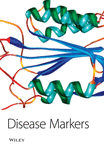Expression of MAGE-A12 in Oral Squamous Cell Carcinoma
Abstract
Melanoma associated-A antigens (MAGE-A) are silent in normal tissues except testis. However, they are activated in a variety of different tumors. Thus, their expression is highly specific to cancer cells. Reverse transcription-nested polymerase chain reaction (RT-nPCR) is a highly sensitive technique that has been used successfully for the detection ofMAGE genes in tissue samples. The aim of the study is to analyze the expression rate of MAGE-A12 in oral squamous cell carcinoma (OSCC) using a high sensitive RT-nPCR. Total of 57 tissue samples obtained from patients with OSCC and 20 normal oral mucosal (NOM) probes of otherwise healthy volunteers were included to this study. No expression of MAGE-A12 was observed in the non-neoplastic NOM tissues. MAGE-A12 was expressed in 49.1% of the investigated tumor samples. The correlation between malignant lesion and MAGE-A12 detection was significant (p < 0.001). It is concluded that results of this study may indicate MAGE-A12 as a useful additional diagnostic marker especially for the early detection of OSCC distinguishing neoplastic transformation and detection of occult and/or rare disseminated cancer cells. In addition, MAGE-A12 expression in OSCC may also determine a new immunotherapeutic target and might be warranted to develop vaccine for OSCC.




